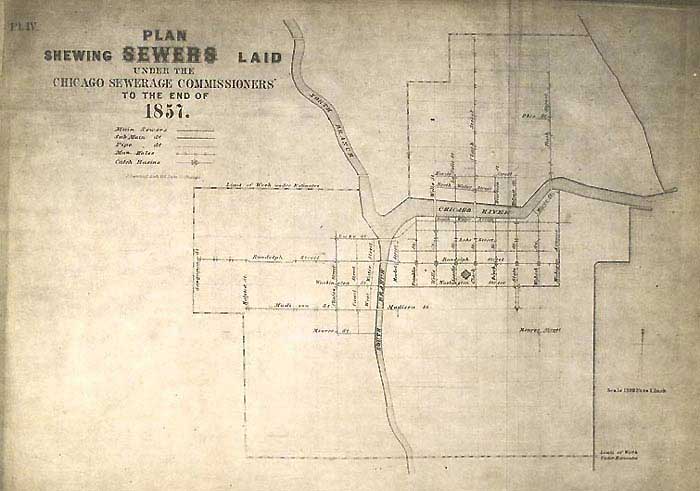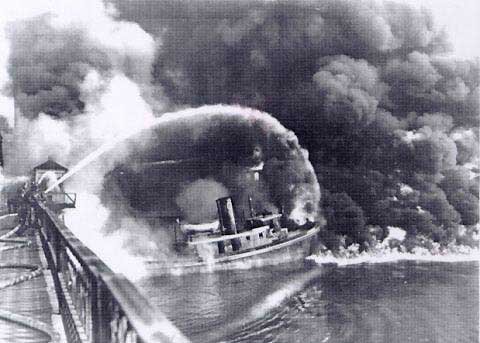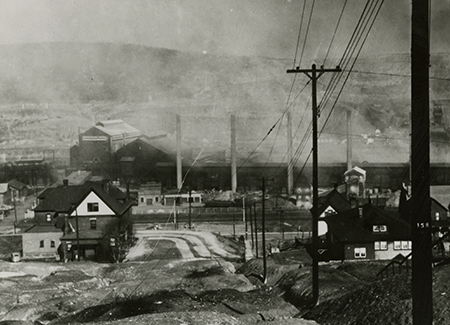A Brief History of Pollution
Pollution Tutorial
Pollution is not a new phenomenon. In fact, pollution has been a problem since the appearance of our earliest ancestors. Increasing human populations have opened the door to more bacteria and disease. During the Middle Ages, diseases such as cholera and typhoid fever broke out all across Europe. These epidemics were directly related to unsanitary conditions caused by human and animal wastes, and garbage. In 1347, the bacterium Yersinia pestis, carried by rats and spread by fleas, caused the "Black Death" — an outbreak of bubonic plague. Unsanitary conditions provided the perfect environment for the deadly bacteria to flourish.

This is a magnified image of Xenopsylla cheopis (oriental rat flea) engorged with blood. This flea is the transmitter of plague diseases in Asia, Africa, and South America. Both male and female fleas can transmit the infection.
By the 1800s, people began to understand that unsanitary living conditions and water contamination contributed to disease epidemics. This new awareness prompted major cities to take measures to control waste and garbage. In the mid-1850s, Chicago built the first major sewage system in the United States to treat wastewater. Soon, many other U.S. cities followed Chicago's lead.
Improved sanitary conditions and less disease were important factors in making cities healthier places to live, and helped encourage people to move to urban areas. As cities became more populated towards the end of the 19th century, industrialized cities across Europe and the United States were experiencing a new kind of pollution: waste from industries and factories. In 1897, a report to the Royal Commission on River Pollution detailed the gross industrial contamination of the Tawe River in Wales, noting that it was polluted by "alkali works, copper works, sulfuric acid liquid, sulfate of iron from tin-plate works, and by slag, cinders and small coal."
In the United States, industrial chemicals and wastes, including sulfuric acid, soda ash, muriatic acid, limes, dyes, wood pulp, and animal byproducts from industrial mills contaminated waters in the Northeast.

This map shows the layout of sewers in Chicago at the end of 1857. Chicago built one of the first sewage systems in the United States to treat wastewater.
Water and air pollution in U.S. urban areas continued to increase well into the 20th century. The Cuyahoga River in Cleveland, Ohio, which flows into Lake Erie, became so polluted that the water erupted into flames! The first fire occurred in 1936, when a spark from a blowtorch ignited floating debris and oils. Over the next 30 years, the river caught fire several more times.
In 1969, another major fire erupted. This time, with the help of news and magazine coverage, the fire prompted the nation to take immediate action against water pollution. The public response to this event helped create the Federal Water Pollution Control Act (1972), commonly called the Clean Water Act. This legislation provides money to improve sewage treatment plants and sets limits on the things that industries and treatment plants can discharge into the water. The Cuyahoga River fires also provided the motivation to create the Great Lakes Water Quality Agreement; establish federal and state environmental protection agencies; and pass the Oil Pollution Act of 1990, which prohibits the discharge of oil into navigable rivers.
Air pollution from automobiles, industrial processes, and the burning of coal in factories and in homes has also been a serious problem. In the 19th century, episodes of "smog" (a combination of smoke and fog) in cities like New York and London resulted in many deaths. Air pollution continued to be a significant problem up through the middle of the 20th century. In late October of 1948, 20 people were asphyxiated and more than 7,000 became seriously ill as the result of severe air pollution over Donora, Pennsylvania.
Like the 1969 Cuyahoga River fire, the 1948 Donora incident led to the creation of the Air Pollution Control Act of 1955. This was the first federal attempt to control air pollution. Since then, clean air legislation has been revised and strengthened. The Clean Air Act of 1990 sets limits on the discharge of air pollutants from industrial facilities and motor vehicles, and addresses acid rain and ozone depletion.
These laws have significantly reduced the amount of pollution released into the environment. Grossly contaminated water and air are much less common today than they were 50 years ago. Nevertheless, some of today's experts are concerned about the possible risks of continuous low-level exposure to pollutants, and particularly to nonpoint source pollutants.

Firefighters battle a fire on Ohio's Cuyahoga River in 1952. The polluted river caught fire on several occasions between 1936 and 1969, when debris and oil had concentrated on the water's surface and ignited. A blaze in 1969 came at a time of increasing environmental awareness and symbolized years of environmental neglect. The Cuyahoga River fires helped spur grassroots activism that resulted in a wave of federal legislation devoted to taking serious action against air and water pollution.

A view of a factory and several smokestacks in the town of Donora, PA, shortly after a deadly smog episode in October 1948. The smog enveloped the town, asphyxiating 20 people and making more than 7,000 seriously ill.
Pollution Lessons
- Welcome
- A Brief History of Pollution
- Point Source
- Nonpoint Source
- Urban and Suburban Areas
- Agricultural Operations
- Atmospheric Inputs
- Forestry and Mining Operations
- Marinas and Boating Activities
- Nutrients
- Suspended Sediments
- Pesticides and Toxic Chemicals
- Bacteria, Viruses, and Trash
- Research, Monitoring, and Assessment
- Controlling Nonpoint Source Pollution
- What You Can Do
- References
- Roadmap to Resouces
- Subject Review (PDF)
Categories of Pollution
Pollutants from Nonpoint Sources
